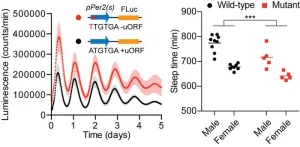(Press-News.org) Observations of the BlueWalker 3 prototype satellite show it is one of the brightest objects in the night sky, outshining all but the brightest stars.
Astronomers have raised concerns that without mitigation, groups of large satellites could disrupt our ability to observe the stars from Earth and perform radio astronomy.
Several companies are planning ‘constellations’ of satellites – groups of potentially hundreds of satellites that can deliver mobile or broadband services anywhere in the world.
However, these satellites need to be in ‘low-Earth’ orbit and can be relatively large, so their potential to disrupt night-sky observations is a concern.
Now, an international team of scientists led by astronomers from the IAU Centre for the Protection of the Dark and Quiet Sky from Satellite Constellation Interference (CPS) and including Imperial College London researchers, have published a paper in Nature assessing the detailed impact of the prototype BlueWalker 3 satellite on astronomy.
Dr Dave Clements, from the Department of Physics at Imperial, said: “The night sky is a unique laboratory that allows scientists to conduct experiments that cannot be done in terrestrial laboratories. Astronomical observations have provided insights into fundamental physics and other research at the boundaries of our knowledge and changed humanity’s view of our place in the cosmos. The pristine night sky is also an important part of humanity’s shared cultural heritage and should be protected for society at large and for future generations.”
Bright observations
BlueWalker 3 was launched into low-Earth orbit on 10 September 2022 by AST SpaceMobile, as a prototype for a planned constellation of over a hundred similar satellites intended for use in mobile communications. Observations taken within weeks of the launch showed that the satellite was among the brightest objects in the sky.
However, to better understand its effects on astronomy, the CPS initiated an international observing campaign. As part of this initiative, both professional and amateur observations were contributed from across the world, from sites in Chile, the US, Mexico, Aotearoa New Zealand, the Netherlands, and Morocco.
Documenting BlueWalker 3’s brightness over a period of 130 days, the newly released data show an abrupt increase coinciding with the complete unfolding of the antenna array, which at 64 square meters is the largest commercial antenna system ever deployed into low-Earth orbit.
A subset of the observations were also used to calculate the satellite’s trajectory over time. Comparing the predicted path with the observations collected, the authors were able to evaluate the accuracy of predictions and how this can change due to factors such as atmospheric drag.
Knowing the positions of the satellites is important, so astronomers can try to avoid them or at least know where they will be in the data. However, mitigating against the brightness is difficult beyond masking their position and losing data for that portion of the sky.
Radio interference
Besides visible observations, BlueWalker 3 could also interfere with radio astronomy, since it uses wavelengths close to those that radio telescopes observe in. While some telescopes are located within designated radio quiet zones, the restrictions in place to preserve these areas currently only apply to terrestrial transmitters, so they are not necessarily protected from satellite transmission.
Dr Mike Peel, co-lead of IAU CPS's Sathub and researcher in the Department of Physics at Imperial, said: "BlueWalker 3 actively transmits at radio frequencies that are close to bands reserved for radio astronomy, and existing observatory protections from radio interference may not be sufficient. Further research is therefore required to develop strategies for protecting existing and upcoming telescopes from the numerous satellites planned for launch over the next decade.”
The IAU and CPS partners recognize that the new satellite constellations have an important role in improving worldwide communications. However, their interference with astronomical observations could severely hamper progress in our understanding of the cosmos. Their deployment should therefore be conducted with due consideration of their side effects and with efforts made to minimize their impact on astronomy.
Observations of BlueWalker 3 will continue, with plans by astronomers to observe its thermal emission later this year. Astronomers will continue to discuss this topic at the upcoming IAU Symposium: Astronomy and Satellite Constellations: Pathways Forward in October.
END
Massive low earth orbit communications satellites could disrupt astronomy
2023-10-02
ELSE PRESS RELEASES FROM THIS DATE:
Nerve cells can detect small numbers of things better than large numbers of things
2023-10-02
When two, three or four apples are placed in front of us, we are able to recognize the number of apples very quickly. However, we need significantly more time if there are five or more apples and we often also guess the wrong number. In fact, the brain does actually register smaller numbers of things differently than larger ones. This has been demonstrated in a recent study by the University of Tübingen, University of Bonn and the University Hospital Bonn. The results were published in the magazine Nature ...
Boston Children’s Hospital researchers uncover insights into the developmental trajectory of autism
2023-10-02
In a groundbreaking study published in JAMA Pediatrics on October 2, 2023, researchers at Boston Children’s Hospital shed new light on the evolving nature of Autism Spectrum Disorder (ASD) diagnoses in early childhood. Diagnosing ASD at a young age is important for early intervention and treatment, but this new study suggests that not all kids continue to meet the criteria for ASD as they get older.
The team found that 37% of children diagnosed with ASD as toddlers no longer meet the criteria for ASD around the age of six. Children with lower adaptive skills—essential everyday abilities encompassing communication, self-care, and decision-making—tend ...
Sustainable protection of rapidly subsiding coastlines with mangroves
2023-10-02
Vulnerable coastlines
Unfortunately, precisely in these rural densely populated Asian regions, mangroves have in the past been cleared to free up land for other uses such as aquaculture. This has made these coasts vulnerable to rapid erosion. Restoring mangroves seems a logical solution to reverse this process and protect these densely populated coastlines. However, this requires understanding if mangroves can cope with extreme rates of relative sea level rises, as experienced in these subsiding areas.
Since 2015 NIOZ researcher Celine van Bijsterveldt visited Indonesia regularly during her studies and her Phd. ...
Boreal and temperate forests now main global carbon sinks
2023-10-02
Using a new analysis method for satellite images, an international research team, coordinated by the French Alternative Energies and Atomic Energy Commission (CEA) and INRAE, mapped for the first time annual changes in global forest biomass between 2010 and 2019. Researchers discovered that boreal and temperate forests have become the main global carbon sinks. Tropical forests, which are older and degraded by deforestation, fire and drought, are nearly carbon neutral. The findings, published in Nature Geoscience, highlight the importance of accounting for young forests and forest ...
Differences in mortality rates for fatal cerebral haemorrhage between Finnish university hospitals
2023-10-02
Subarachnoid haemorrhage (SAH) is one of the most dangerous cerebrovascular disorders, with as many as 40% of patients dying within one month of the event.
A study recently published in the esteemed Neurology journal investigated whether there are differences in the prognosis of SAH patients between the university hospital districts in Finland. The research dataset was composed of nearly 10,000 SAH cases from 1998 to 2017, including information on patients who died before receiving neurosurgical care.
Prognoses ...
Smooth avatar-user synchronization for the metaverse
2023-10-02
Mobile phones, smartwatches and earbuds are some gadgets that we carry around physically without much thought. The increasingly digitalised world sees a shrinking gap between human and technology, and many researchers and companies are interested in how technology can be further integrated into our lives.
What if, instead of incorporating technology into our physical world, we assimilate ourselves into a virtual environment? This is what Assistant Professor Xiong Zehui from the Singapore University of Technology ...
Defense against the enemy within
2023-10-02
The research teams of Professor René Ketting at the Institute of Molecular Biology (IMB) in Mainz, Germany, and Dr. Sebastian Falk at the Max Perutz Labs in Vienna, Austria, have identified a new enzyme called PUCH, which plays a key role in preventing the spread of parasitic DNA in our genomes. These findings may reveal new insights into how our bodies detect and fight bacteria and viruses to prevent infections.
Our cells are under constant attack from millions of foreign intruders, such as viruses and bacteria. To keep us from getting sick, ...
New tool reveals how drugs affect men, women differently -- and will make for safer medications
2023-10-02
UVA Health researchers have developed a powerful new tool to understand how medications affect men and women differently, and that will help lead to safer, more effective drugs in the future.
Women are known to suffer a disproportionate number of liver problems from medications. At the same time, they are typically underrepresented in drug testing. To address this, the UVA scientists have developed sophisticated computer simulations of male and female livers and used them to reveal sex-specific differences in how the tissues are affected by drugs.
The new model has already provided ...
Researchers develop mixture of compounds to help preserve organs before transplantation
2023-10-02
Using zebrafish as a model, investigators have determined a suitable combination of chemical compounds in which to store hearts, and potentially other organs, when frozen for extended periods of time before transplantation.
The work, which is published in The FASEB Journal, involved a variety of methods, including assays at multiple developmental stages, techniques for loading and unloading agents, and the use of viability scores to quantify organ function.
These methods allowed scientists to perform the largest and most comprehensive screen of cryoprotectant agents to determine their toxicity and efficiency at preserving ...
A surprising way to disrupt sleep
2023-10-02
Osaka, Japan - Circadian rhythms, the internal biological clocks that regulate our daily activities, are essential for maintaining health and well-being. While the role of transcription in these rhythms is well-established, a new study sheds light on the critical importance of post-transcriptional processes. The research, titled “Circadian ribosome profiling reveals a role for the Period2 upstream open reading frame in sleep,” to be published in PNAS, redefines our understanding of how translation and post-transcriptional processes influence the body’s internal clock and its impact on sleep patterns.
Timing Is Everything: ...








